Ancient Civilizations of Mesoamerica
Understanding Mesoamerica
Mesoamerica is the story of many different cultures that lived and thrived in central Mexico and Central America over 3,000 years. These groups were known for their amazing art, smart ideas, and impressive buildings. Understanding the term "Mesoamerica" helps us see how these different peoples were connected by shared traditions.
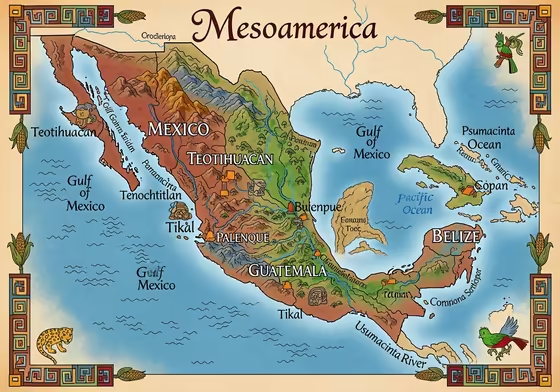
What Were Mesoamerican Civilizations?
The term "Mesoamerican civilizations" describes the native cultures that grew in a part of the Americas before the Spanish arrived in the 1500s. This was one of the few places on Earth where civilization developed on its own. Even though people spoke many languages and lived in different environments, they shared important cultural beliefs and practices.
What is Mesoamerica?
Mesoamerica is a region that stretches from central Mexico down through Central America. It includes countries like Guatemala, Belize, and El Salvador. The borders of this cultural area changed over time as different civilizations grew stronger or weaker.
Why is it called Mesoamerica?
The name "Mesoamerica" was created in 1943 by a scholar named Paul Kirchhoff. It comes from the Greek word mesos , which means "middle," so it means "Middle America." Kirchhoff used the term to describe a region where ancient cultures shared similar traits, separating them from other groups to the north and south.
What Did It Mean to Be Mesoamerican?
Ancient people in this area did not call themselves "Mesoamerican." Their identity was tied to their own city or community, like being from the city of Tikal or being part of the Zapotec people. A person's loyalty was to their own group, not a larger region.
Today, we use the term "Mesoamerican" to describe cultures that shared certain traditions. These include a diet of corn, beans, and squash, and building stepped pyramids. They also shared a religion with many gods and played a special ritual ballgame.
The Geography of Mesoamerica
The geography of Mesoamerica is very diverse, which played a big role in how its civilizations developed. The land can be split into two main types: highlands and lowlands.
- The Highlands (Altiplanos): These are the mountainous areas in central Mexico and Guatemala. The climate is cooler, and volcanoes in the region made the soil very rich and good for farming. The highlands were also a source of obsidian, a sharp volcanic glass used for tools and weapons.
- The Lowlands: This zone has a warmer, tropical climate and includes the Gulf Coast, the Yucatán Peninsula, and rainforests. This area was home to the Olmec and Maya people. The lowlands provided special resources like rubber, cacao (for chocolate), and colorful bird feathers.
This variety in the land meant that no single area had everything it needed. People in the highlands wanted goods like salt and cotton from the lowlands. People in the lowlands needed resources like obsidian from the highlands.
This need for trade created large networks that connected the entire region. These trade routes were used to exchange goods, but also ideas, art, and religious beliefs. This is how so many different cultures ended up sharing a similar way of life.
Does Mesoamerica still exist?
The great cities are now ruins, but Mesoamerican culture is not gone. Millions of descendants of these ancient people still live in Mexico and Central America today. In fact, the Maya population is about the same size now as it was before the Spanish arrived.
Many ancient traditions continue, especially in language. Mayan languages and the Aztec language Nahuatl are still spoken by millions. Foods like chocolate, avocado, and tomatoes first came from this region and are now enjoyed worldwide.
Major Civilizations of Mesoamerica
Mesoamerica was not one single group but a mix of many different cultures. Over thousands of years, great civilizations rose and fell. While some names are very famous, there were many important centers of power and new ideas.
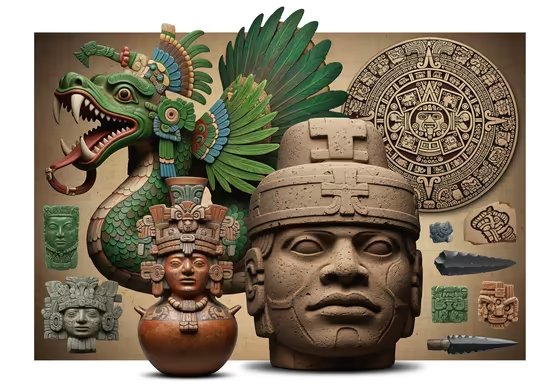
Who Were the Major Civilizations?
While many cultures lived in the region, six are often seen as the most important because of their influence and achievements. These are the Olmec, Maya, Zapotec, Teotihuacan, Toltec, and Aztec (Mexica).
- The Olmec (c. 1600–400 BCE) are known as the "mother culture" of Mesoamerica because they started many traditions that later cultures followed.
- The Maya (c. 2000 BCE–1697 CE) are famous for their amazing achievements in writing, math, and astronomy.
- The Zapotec (c. 700 BCE–1521 CE) were a powerful group in the Oaxaca Valley for a very long time, with their capital at Monte Albán.
- Teotihuacan (c. 100 BCE–550 CE) was a huge city that was one of the largest in the world at its peak and influenced all of Mesoamerica.
- The Toltec (c. 900–1150 CE) were known as great warriors in central Mexico. The later Aztecs admired them and claimed to be their descendants.
- The Aztec (c. 1345–1521 CE), also called the Mexica, built the largest and most powerful empire in Mesoamerica's history from their capital, Tenochtitlan.
It is important to know that the Inca were not a Mesoamerican civilization. The Inca empire was located in South America, mainly in modern-day Peru. They belonged to a completely separate cultural region.
Other Mesoamerican Cultures
Besides these major groups, many other important cultures lived in Mesoamerica. This shows how diverse the region truly was. Other notable peoples include:
- Mixtec
- Totonac
- Tarascan (Purépecha)
- Huastec
- Mezcala
- Pipil
- Chichimec
This list is not complete, as archaeologists continue to learn more about the rich history of the area.
Where Did They Live? A Map
Seeing where these civilizations were located helps us understand how they interacted. A map of the region would show these general locations:
- Gulf Coast: The Olmec lived on the humid coastal plains. The Totonac and Huastec also lived in this area.
- Maya Area: This large territory covers the Yucatán Peninsula, Belize, Guatemala, and parts of Honduras and El Salvador.
- Central Highlands: The high Valley of Mexico was home to the city of Teotihuacan and later, the Aztec Empire.
- Oaxaca: This mountainous region to the south was home to the Zapotec and later the Mixtec.
- West Mexico: This area was home to distinct cultures known for their unique pottery and burial traditions.
These civilizations did not live in isolation from each other. Later cultures often borrowed traditions, gods, and art from the cultures that came before them. This helped them build their own identity and prove they had a right to rule.
For example, the Aztecs looked up to the Toltecs as their ancestors. The Toltecs, in turn, were influenced by the great city of Teotihuacan. This shows how each civilization was a new chapter in one long, connected story.
Interesting Facts
- A Diet of "The Three Sisters": The main food source for all Mesoamerican civilizations was corn (maize), beans, and squash. When grown together, these three crops help each other thrive.
- The Ritual Ballgame: A special sport was played with a solid rubber ball on I-shaped courts. The game was very important for religion and politics, and sometimes players were sacrificed at the end.
- Monumental Builders: These cultures built huge structures, especially stepped pyramids that were used as temples. They did this without metal tools, wheels, or large animals like horses or oxen.
- Complex Calendars: Mesoamerican societies shared a smart timekeeping system. It included a 260-day ritual calendar and a 365-day solar calendar that lined up every 52 years.
Specific Civilizations
The Aztecs (Mexica)
The Aztec civilization, whose people were called the Mexica, was the last great native power in Mesoamerica before the Europeans arrived.

- Timeline and Key Cities: The Mexica arrived in the Valley of Mexico and founded their capital, Tenochtitlan, in 1325 CE on an island in a lake. They formed the Triple Alliance with two other cities, which became the Aztec Empire. The empire was at its height before it was conquered by the Spanish led by Hernán Cortés in 1521 CE.
- Social and Political Structure: Aztec society was strictly organized. The emperor, or Huey Tlatoani ("Great Speaker"), was at the top and seen as almost a god. Below him were nobles, priests, and warriors, followed by common people who farmed the land. Conquered cities were forced to pay tribute (goods and resources) to the empire.
-
Major Achievements:
- Engineering and Urbanism: Tenochtitlan was an amazing feat of engineering. The Aztecs built causeways to connect the island city to the shore and created chinampas , or "floating gardens," to grow food year-round in the lake.
- Empire Building: The Aztecs were skilled warriors and created the largest empire in Mesoamerican history. They controlled most of central Mexico from the Gulf Coast to the Pacific Ocean.
- Education: The Aztecs had a required school system for all children, including boys and girls. Children of nobles and commoners attended different schools to learn about religion, government, or practical skills.
- Decline: The Aztec Empire fell quickly after the Spanish arrived in 1519. The Spanish leader Hernán Cortés made alliances with local groups who hated Aztec rule. But the most deadly factor was European diseases like smallpox, which killed huge numbers of Aztecs who had no immunity.
The Maya
The Maya civilization was one of the longest-lasting and smartest cultures of the ancient world. They are known for their complex writing, math, and astronomy.
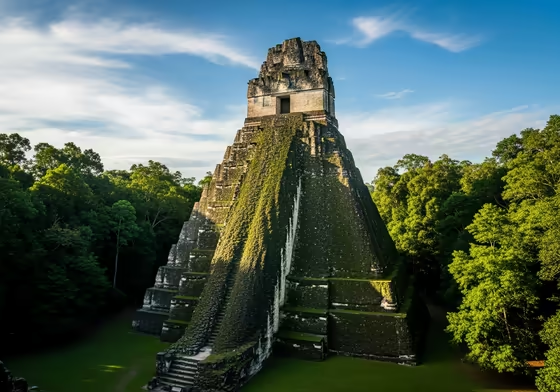
-
Timeline and Key Cities:
Maya history is very long and is split into three main periods.
- Preclassic Period (c. 2000 BCE–250 CE): In this early time, the first Maya villages and farms were established. Large cities like El Mirador began to appear.
- Classic Period (250–900 CE): This was the peak of Maya civilization, when powerful city-states like Tikal, Palenque, and Copán thrived. They built tall monuments with carved histories.
- Postclassic Period (900–1519 CE): After the southern cities collapsed, Maya civilization shifted north to cities like Chichén Itzá. The last independent Maya kingdom survived until 1697.
- Social and Political Structure: The Maya world was not a single empire but a collection of competing city-states. Each city was ruled by a divine king who was both a political and religious leader. Society was divided into classes, including royals, priests, warriors, and farmers.
-
Major Achievements:
- Writing System: The Maya created the most advanced writing system in the ancient Americas. This allowed them to record their history, science, and religious beliefs in great detail.
- Mathematics and Astronomy: The Maya were brilliant mathematicians who developed the concept of zero. They were also skilled astronomers who created very accurate calendars to track planets and predict eclipses.
- Architecture and Art: The Maya built incredible cities with towering pyramids, palaces, and observatories. They also created beautiful art, including detailed carvings, murals, and painted pottery.
- Decline (The Classic Maya Collapse): Around 900 CE, the great Maya cities in the south were suddenly abandoned. Scholars believe a combination of problems caused this collapse, including long droughts, environmental damage from over-farming, constant warfare between cities, and a loss of faith in the divine kings.
The Olmec
The Olmec are known as the first great, complex society of Mesoamerica. They are often called the "mother culture" because they influenced all the civilizations that came after them.
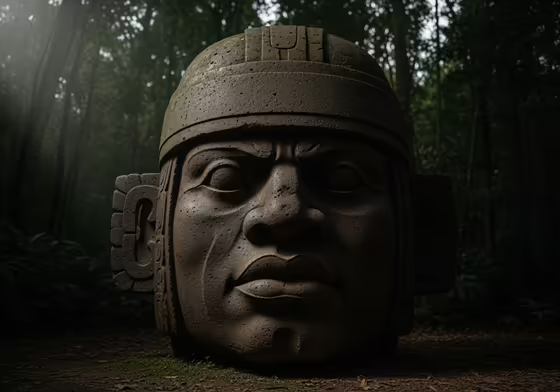
- Timeline and Key Cities: The Olmec lived in the tropical lowlands along the Gulf Coast of Mexico from about 1600 to 400 BCE. Their first major center was San Lorenzo. After it declined, their main center of power moved to La Venta.
- Social and Political Structure: Building huge monuments required a very organized society. A powerful group of rulers and priests likely directed large groups of workers. Most people were farmers who lived in nearby villages and supported the leaders.
-
Major Achievements:
- Monumental Sculpture: The Olmec are most famous for carving giant stone heads. These massive sculptures, which can weigh up to 50 tons, are believed to be portraits of Olmec rulers.
- Foundational Cultural Traits: The Olmec started many traditions that defined Mesoamerica. These include building pyramids, playing a ritual ballgame, and developing key religious ideas, like worshiping a jaguar god.
- Intellectual Innovations: The Olmec are thought to have developed one of the earliest writing and calendar systems in Mesoamerica. This laid the groundwork for the more complex systems of later cultures.
- Decline: The Olmec civilization declined around 400 BCE, when their major centers were abandoned. The exact reasons are unknown, but it was likely due to environmental changes. Volcanic eruptions and the shifting of rivers may have ruined their farmlands.
Teotihuacan
For centuries, the great city of Teotihuacan was the most powerful cultural and economic center in Mesoamerica. It was a huge city, and its influence was so great that cultures like the Aztecs honored it 1,000 years after it fell. Compare it with the later Aztec capital: Teotihuacan vs Tenochtitlan.
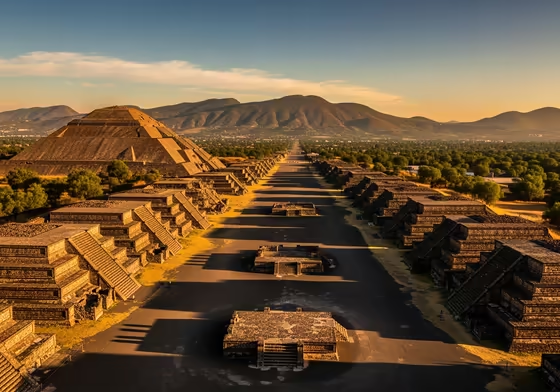
- Timeline and Key Cities: The civilization was based in one massive city: Teotihuacan, located in the Valley of Mexico. The city was founded around 100 BCE and reached its peak between 200 and 550 CE, when it was one of the largest cities in the ancient world. Around 550 CE, the city suddenly collapsed when its main buildings were burned.
- Social and Political Structure: How Teotihuacan was ruled is a mystery. It may have been governed by a council of powerful leaders instead of a single king. The city was home to people from many different regions, who lived in their own neighborhoods and kept their own traditions.
-
Major Achievements:
- Urban Planning and Architecture: Teotihuacan was a masterpiece of city planning, built on a strict grid system. It is home to massive buildings like the Pyramid of the Sun and the Pyramid of the Moon.
- Cultural and Economic Power: Teotihuacan's influence spread across Mesoamerica through trade. Its unique pottery and architectural styles have been found hundreds of miles away. The city controlled major sources of obsidian, which it used to make tools and weapons.
- Residential Compounds: Most of the city's people lived in large, multi-family apartment buildings made of stone. Many of these buildings were decorated with colorful painted murals.
- Decline: The end of Teotihuacan was sudden and violent. Around 550 CE, the main temples and palaces were burned down on purpose. This suggests the collapse was caused by an internal conflict, such as an uprising of the people against their rulers, rather than a foreign invasion.
The Zapotec
The Zapotec civilization was one of the longest-lasting cultures of Mesoamerica, thriving for over 2,500 years in the Valley of Oaxaca.
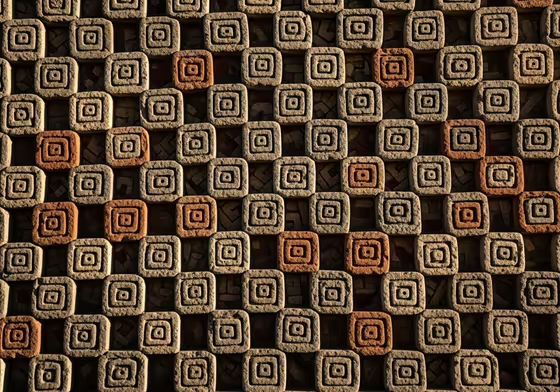
- Timeline and Key Cities: Around 500 BCE, the Zapotec founded their capital, Monte Albán, on a mountaintop overlooking the valley. Monte Albán was the center of the Zapotec state for nearly 1,500 years. After its power faded around 900 CE, other Zapotec centers like Mitla became important.
- Social and Political Structure: Zapotec society was led by a divine king who was both a political and religious leader. Below the king were nobles and priests. Most of the people were farmers and artisans who paid tribute to the leaders in Monte Albán.
-
Major Achievements:
- Writing and Calendar: The Zapotecs developed one of the earliest writing systems in Mesoamerica. Their script is considered a forerunner to the writing of the Maya, Mixtec, and Aztec.
- Urban Planning: Monte Albán was one of Mesoamerica's first great cities. It was carefully planned with a large central plaza surrounded by temples, palaces, and a ball court.
- Architecture: The later Zapotec city of Mitla is famous for its unique and beautiful architecture. Its palace walls are covered in complex geometric patterns made from thousands of small, perfectly cut stones fitted together without mortar.
- Decline: The power of Monte Albán began to weaken around 900 CE, and the Zapotec split into smaller, separate kingdoms. This made them vulnerable to attack from their neighbors, the Mixtecs. Later, the expanding Aztec Empire conquered most of the remaining Zapotec kingdoms.
Timeline and Chronology
To understand Mesoamerica's long history, we can use a timeline that organizes its many cultures. Archaeologists have divided this history into several major periods. This timeline shows a story of development, from the first farming villages to great empires.
Timeline of Mesoamerican Civilizations
The history of Mesoamerica is usually organized into the following periods. This helps put the rise of its civilizations in a clear order.
- Paleo-Indian Period (c. 12,000–8000 BCE): This is when the first people arrived in the region. They were nomadic hunter-gatherers who hunted large Ice Age animals.
- Archaic Period (c. 8000–2000 BCE): During this time, people slowly began to rely more on plants for food. They started to grow important crops like corn, beans, and squash, which led to the first permanent villages.
- Preclassic (or Formative) Period (2000 BCE–250 CE): This was a time of great change when the first complex societies appeared. The Olmec civilization rose, and people began making pottery, building large ceremonial centers, and developing writing.
- Classic Period (250–900 CE): This was the golden age of Mesoamerican cities and learning. The period was dominated by the great city of Teotihuacan in central Mexico and the powerful city-states of the Maya.
- Postclassic Period (900–1521 CE): After the great cities of the Classic period collapsed, this era was marked by more warfare and the movement of people. New powers like the Toltecs and then the Aztecs rose. The period ended when the Spanish conquered the Aztec Empire in 1521.
The following table provides a visual summary of this timeline, highlighting the major cultures and developments of each period.
| Period | Timespan | Key Characteristics | Major Cultures & Cities |
|---|---|---|---|
| Paleo-Indian | ~12,000–8000 BCE | First human presence, nomadic hunter-gatherer groups, big-game hunting. | Iztapan, Santa Isabel Iztapan |
| Archaic | ~8000–2000 BCE | Domestication of maize, beans, squash; transition to sedentary agricultural villages. | Tehuacán Valley settlements |
| Preclassic (Formative) | 2000 BCE–250 CE | Rise of complex societies, pottery, large-scale ceremonial architecture, development of writing and calendars. | Olmec (San Lorenzo, La Venta), Early Maya (Nakbe, El Mirador), Early Zapotec (San José Mogote) |
| Classic | 250–900 CE | Peak of urbanism, state-level societies, monumental art and architecture, major intellectual achievements. | Teotihuacan, Classic Maya (Tikal, Calakmul, Palenque, Copán), Classic Zapotec (Monte Albán) |
| Postclassic | 900–1521 CE | Political fragmentation, increased warfare and militarism, rise of new empires, use of metallurgy. | Toltec (Tula), Aztec (Tenochtitlan), Post-Classic Maya (Chichén Itzá, Mayapán), Mixtec (Mitla) |
| Colonial | 1521–1821 CE | Spanish conquest and rule, demographic collapse from disease, cultural syncretism. | Fall of Tenochtitlan (1521) |
Earliest Civilizations
What Was the Oldest Civilization?
The Olmec are considered the oldest major civilization in Mesoamerica. Starting around 1500 BCE, they are often called the "mother culture." This is because they created many of the religious, artistic, and social ideas that later Mesoamerican cultures would follow.
What Was the Oldest City?
The Olmec established the first large ceremonial centers that acted as the heart of their society. The oldest of these is San Lorenzo, which became important around 1200 BCE. As the first major center of a complex civilization, San Lorenzo can be considered the region's first "city."
Who Came Before the Maya?
The Olmec civilization came before the great Maya Classic period. The Olmec reached their peak and had already declined centuries before the Maya golden age began in 250 CE. Early Maya societies were heavily influenced by Olmec culture, likely borrowing ideas about kings, gods, and the ritual ballgame.
Civilization Sequence
Who came first, Maya or Aztec?
The Maya civilization is much older than the Aztec. Maya culture dates back to at least 2000 BCE, and their great cities thrived from 250 to 900 CE. In contrast, the Aztecs were newcomers to the region, founding their capital city of Tenochtitlan in 1325 CE.
What Was the Last Major Civilization?
The Aztec Empire was the last great independent civilization in Mesoamerica before the Spanish arrived. When Hernán Cortés came in 1519, the Aztecs controlled the most powerful empire in the region. Although other groups like the Maya still existed, the Aztecs were the main power at that time.
Culture and Achievements
Even though they lived in different places and spoke different languages, the civilizations of Mesoamerica were connected by a shared culture. This common way of life could be seen in their religion, farming, and unique achievements. This shared heritage developed over thousands of years of contact between different groups.
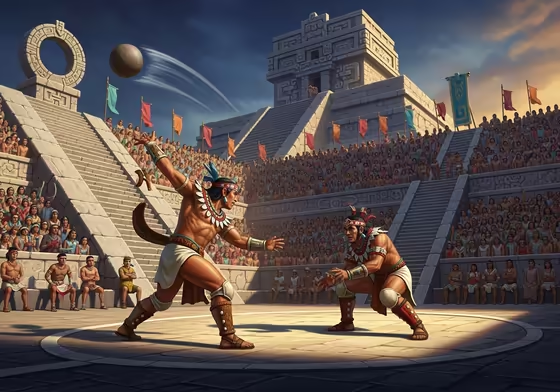
What Did Mesoamerican Cultures Have in Common?
Mesoamerican culture is defined by a set of traits that were shared by most societies in the region. These key features include:
- Agriculture based on Corn, Beans, and Squash: The "Three Sisters" were the foundation of their diet and economy. Corn was especially important and was central to their religion.
- A Religion with Many Gods: They worshiped a large group of gods who represented forces of nature. A rain god and a feathered serpent god were worshiped by nearly every culture.
- Dual Calendar System: They used a complex timekeeping system with two calendars. One was a 260-day ritual calendar, and the other was a 365-day solar calendar for farming.
- Monumental Architecture: They built large cities with stepped pyramids, temples, and palaces. These buildings were the center of community life.
- The Ritual Ballgame: This unique sport was played on I-shaped courts with a solid rubber ball. The game was connected to their religion and sometimes ended in human sacrifice.
- Hieroglyphic Writing: Several cultures developed writing systems to record their history, science, and religious knowledge.
- Organized Society: Their societies were typically divided into classes. This included a ruling class of kings or nobles, priests, warriors, and a large population of commoners.
Contributions of Each Civilization
Each major civilization made its own unique contributions to this shared culture:
- Olmec: As the "mother culture," they provided the basic blueprint. They are known for starting traditions like carving huge stone sculptures, the ritual ballgame, and early writing systems.
- Maya: The Maya were the great thinkers of Mesoamerica. Their key contributions include the most advanced writing system, a complex math system with the concept of zero, and incredibly accurate astronomy.
- Zapotec: The Zapotecs were early city-builders, creating one of the first great cities at Monte Albán. They also developed their own early writing system and a unique style of architecture.
- Teotihuacan: The people of Teotihuacan were expert city planners. Their main contribution was their huge cultural and economic influence, which spread their art and architecture across Mesoamerica.
- Aztec: The Aztecs were brilliant engineers and empire-builders. Their greatest achievements include building the amazing city of Tenochtitlan, forming the largest empire in Mesoamerica, and creating a school system for all children.
Religion
Religion was a central part of life for Mesoamerican civilizations. It was connected to everything they did, from farming and war to tracking time.
What Was Their Religion Like?
Mesoamerican religion involved the worship of many gods and goddesses who represented nature and human life. While each culture had its own set of gods, they often shared similar deities. The most important of these were:
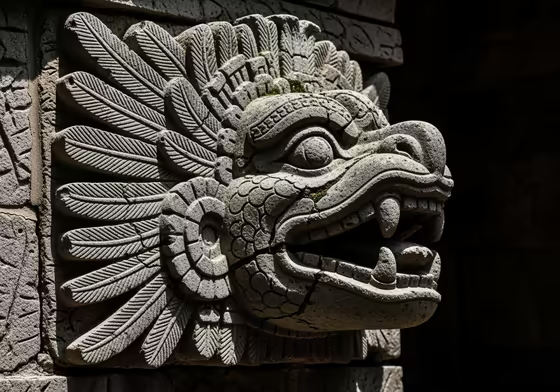
- A Rain and Storm God, who was crucial for farming. He was known as Tlaloc to the Aztecs and Chaac to the Maya.
- A Feathered Serpent God, who was linked to creation, the wind, and knowledge. He was known as Quetzalcoatl to the Aztecs and Kukulkan to the Maya.
They believed the universe had three main levels: a sky world above, the human world in the middle, and an underworld below. The human world was divided into four directions, each with its own color and god.
Rituals were very important and were timed using the 260-day sacred calendar. For many cultures, human sacrifice was part of these rituals. The Aztecs believed that the gods had sacrificed themselves to create the world, and that human blood was needed to keep the sun moving across the sky.
Agriculture
Advanced farming methods were the foundation that allowed the great civilizations of Mesoamerica to grow. Farming allowed people to settle down and build large cities.
How Did They Farm?
The Mesoamerican farming system was very effective and was based on three main crops called the "Three Sisters": corn (maize), beans, and squash. These were often planted together in a field called a milpa . The crops helped each other grow: the cornstalk acted as a pole for the beans, the beans added nutrients to the soil, and the squash leaves provided shade to keep the soil moist.
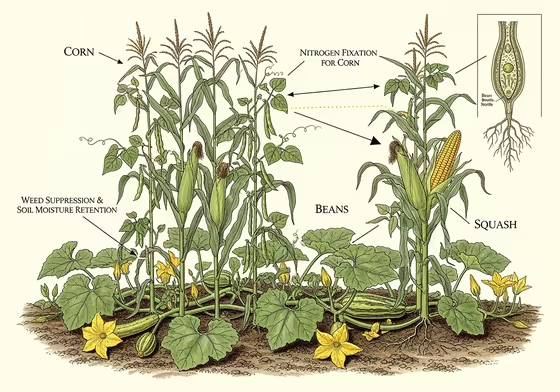
To feed large city populations, Mesoamerican farmers developed several clever techniques:
- Chinampas: The Aztecs perfected this technique of creating "floating gardens." They built artificial islands in the shallow lakes around their city. These garden beds were extremely fertile and could be farmed all year.
- Terrace Farming: In hilly areas, farmers built stone walls on slopes to create a series of flat steps or terraces. This allowed them to farm on steep land and control the flow of water.
- Irrigation Systems: To manage water, these civilizations built canals, dams, and reservoirs. This helped them direct water to their crops, especially during dry seasons.
These farming practices were closely linked to science and religion. Accurate calendars, based on observing the stars, were needed to know the right time to plant and harvest. Religious rituals were also performed to please the gods of farming and rain.
People and Identity
The story of Mesoamerican peoples starts with the first humans who came to the Americas. Their identity was complex and was based on their local communities, not on modern ideas of nations or race.
Where Did Mesoamericans Come From?
The ancestors of all native peoples of the Americas, including Mesoamericans, came from Asia thousands of years ago. The most common theory is that during the last Ice Age, sea levels were lower, creating a land bridge that connected Siberia and Alaska. People walked across this bridge while hunting large animals.
Another popular theory is that some of the first people traveled by boat down the Pacific coast. This could explain why some very old human sites have been found in South America. Most likely, the first Americans arrived in several waves, using both land and sea routes.
Are Mesoamericans Mexican?
This question connects an ancient culture to a modern country. The lands of Mesoamerican civilizations included large parts of what is now Mexico, as well as several other countries in Central America. So, geographically, many Mesoamerican cultures were located in modern-day Mexico.
The link is strongest with the Aztecs, who called themselves the Mexica. Their capital, Tenochtitlan, is the site of modern-day Mexico City, and the name "Mexico" comes from the Mexica people. The eagle and serpent on the Mexican flag today comes from the legend of how the Aztecs founded their city.
What Race Were Mesoamericans?
The modern idea of "race," which is often based on skin color, is not a useful way to think about ancient Mesoamerican societies. This concept did not exist for them.
In ancient Mesoamerica, a person's identity was based on their community, family, and language. Someone would have identified with their city-state and ethnic group. For example, they might see themselves as a Nahua-speaker from the city of Texcoco, not as part of a larger race.
After the Spanish conquest, a strict racial system was forced upon the region. This system was created by the Spanish and put people with European ancestry at the top. This was a completely new and foreign way of thinking about identity for the native peoples.
Are Mesoamericans Native American?
Yes, absolutely. The people of the Mesoamerican civilizations are the native peoples of Mexico and Central America. The term "Native American" is a broad term that refers to all the indigenous peoples of North and South America.
There are also direct links between Mesoamerican peoples and native groups in what is now the United States. For example, the Nahuatl language of the Aztecs belongs to the same language family as the languages of the Hopi people in the Southwest and the Ute people of the Great Basin. This shows they share a common ancestor from long ago.
Five Major Civilizations in Mexico
The area of modern Mexico was home to many great ancient civilizations. Five of the most important are:
- Olmec
- Maya
- Zapotec
- Teotihuacan
- Aztec (Mexica)
Other major cultures that also lived within the borders of modern Mexico include the Toltec and the Mixtec.
Scale and Significance
When we look at the civilizations of Mesoamerica, it is natural to ask which was the "greatest" or "biggest." Answering these questions is complicated, because power and influence can be measured in different ways. A civilization might be important because it lasted a long time, had a big cultural impact, or was very powerful in war.
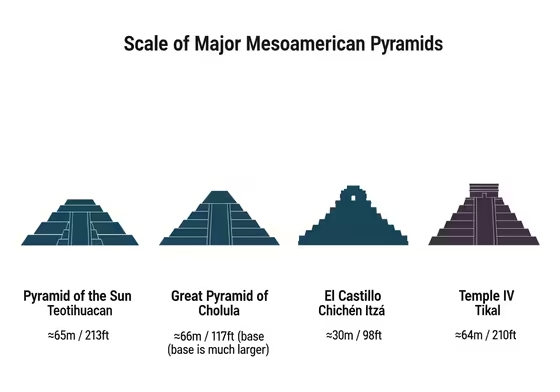
What Was the Greatest Civilization?
There is no single answer for which Mesoamerican civilization was the "greatest," because it depends on what you value most. Each of the major civilizations could be considered the greatest for different reasons.
- By Influence: The Olmec could be called the greatest because they were the "mother culture." Their ideas about art, religion, and society set the pattern for all the cultures that followed.
- By Longevity: The Maya could be seen as the greatest for their ability to survive for nearly 3,000 years. They weathered several collapses and have kept their culture alive to this day.
- By Intellectual Achievement: The Maya are often seen as the greatest for their amazing achievements in learning. They developed the most advanced writing system, invented the concept of zero, and created a highly accurate system of astronomy.
- By Urban Scale: Teotihuacan was arguably the greatest in terms of its size and economic power. At its peak, it was one of the largest and most influential cities in the world.
- By Military Power: The Aztec Empire was the greatest in terms of military strength and political control. At the time the Europeans arrived, they had built the largest and most powerful empire in Mesoamerican history.
What Was the Biggest Empire?
If "biggest" means controlling the most land through military power, then the Aztec Empire was the largest in Mesoamerican history. At its peak in the early 1500s, the Aztec Triple Alliance controlled a large territory and ruled over 5 to 6 million people through a system of tribute.
This shows that there were different kinds of power in Mesoamerica. The Aztec state was a military empire built to collect goods and resources from the people they conquered. In contrast, the power of Teotihuacan seems to have been based more on culture and trade.
The Maya world was never one unified empire, but rather a collection of dozens of competing city-states. So while the Aztecs built the "biggest" empire, the influence of cultures like Teotihuacan and the Maya was also huge in its own way.